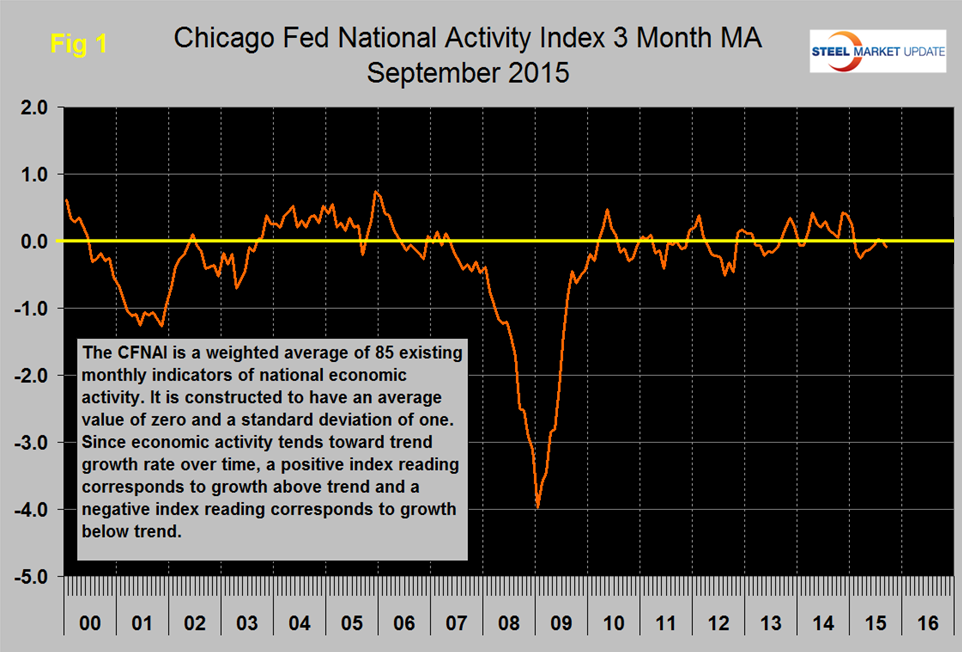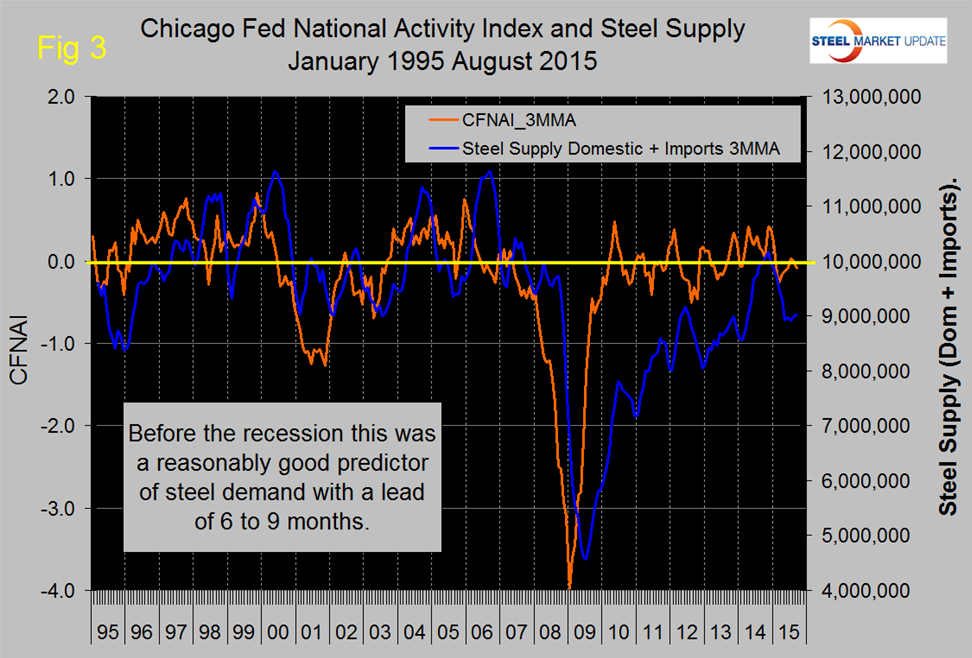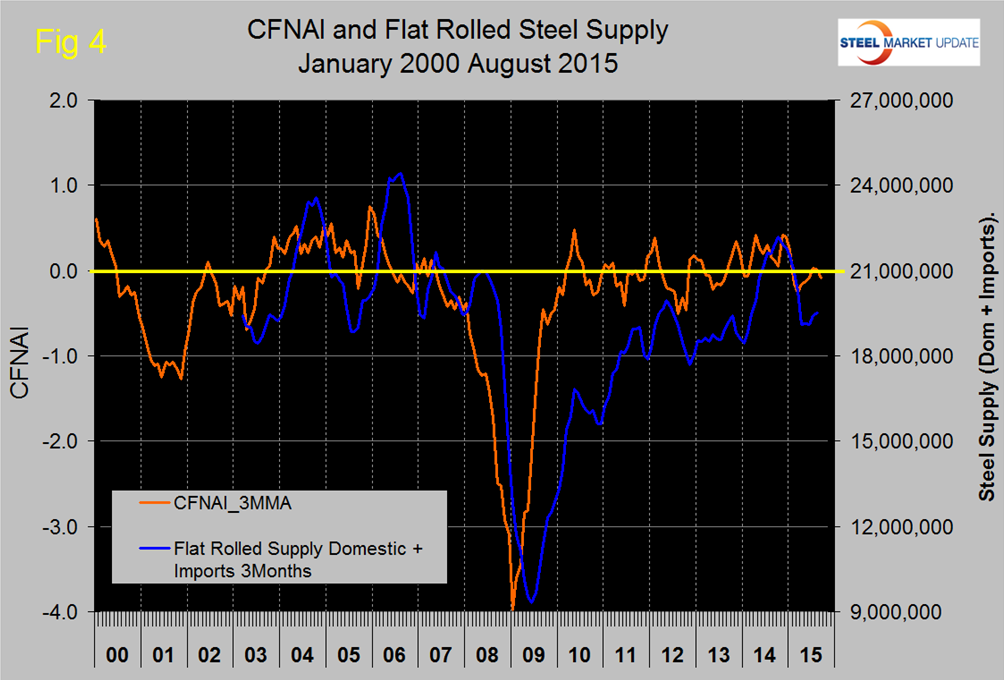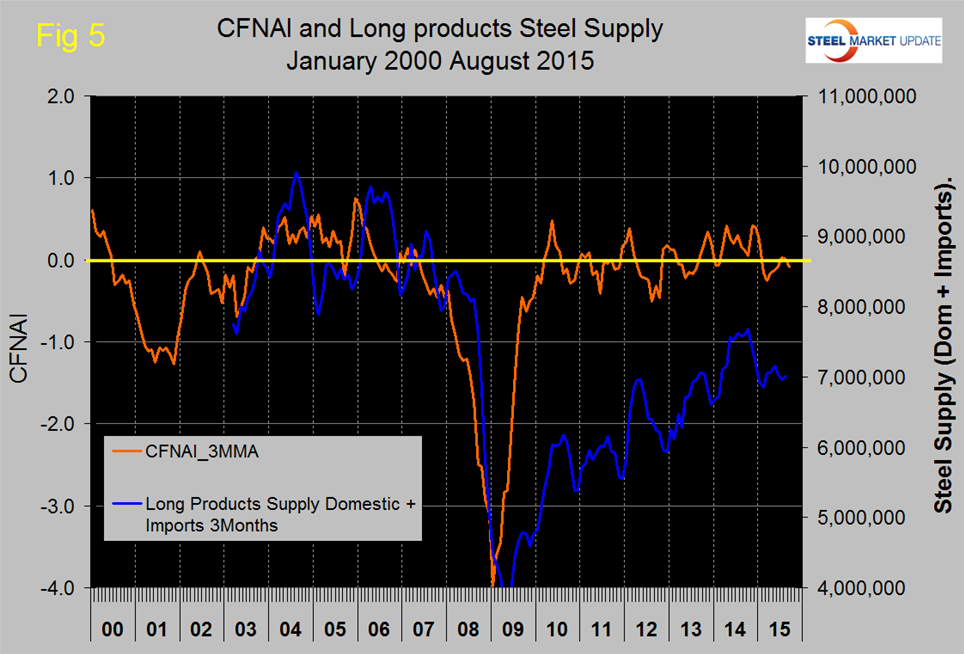Market Data

October 26, 2015
The Chicago Federal Reserve National Activity Index and Steel Supply
Written by Peter Wright
The following is the Chicago Federal Reserve statement followed by our own graphical analysis. The CFNAI is an excellent reality check for much of the economic analysis that we routinely provide in The Steel Market Update and is also a reasonably good predictor of steel demand with a six to nine month lead. For example by the time the steel market went off the cliff in September 2008, the CFNAI had been signaling an increasingly severe problem for eight months. Then in the first Q of 2009 the CFNAI was recovering as steel supply was still going south. An explanation of the Index is provided at the end of this piece.
![]() The official statement reads as follows:
The official statement reads as follows:
Index shows economic growth below average in September
The Chicago Fed National Activity Index (CFNAI) ticked down to –0.37 in September from –0.39 in August. Two of the four broad categories of indicators that make up the index decreased from August, and all four categories made non-positive contributions to the index in September.
The index’s three-month moving average, CFNAI-MA3, decreased to –0.09 in September from +0.01 in August. September’s CFNAI-MA3 suggests that growth in national economic activity was slightly below its historical trend. The economic growth reflected in this level of the CFNAI-MA3 suggests subdued inflationary pressure from economic activity over the coming year.
The contribution from production-related indicators to the CFNAI ticked up to –0.18 in September from –0.21 in August. Manufacturing production moved down 0.1 percent in September, following a decline of 0.4 percent in August. Similarly, the sales, orders, and inventories category made a neutral contribution to the CFNAI in September, up slightly from –0.03 in August.
Employment-related indicators contributed –0.11 to the CFNAI in September, down slightly from –0.08 in August. Civilian employment declined by 0.2 percent in September, following an increase of 0.1 percent in August; however, the unemployment rate was unchanged at 5.1 percent in September.
The contribution of the personal consumption and housing category to the CFNAI ticked down to –0.08 in September from –0.06 in August. Housing permits declined to 1,103,000 annualized units in September from 1,161,000 in the previous month. However, housing starts moved up to 1,206,000 annualized units in September from 1,132,000 in August.
The CFNAI was constructed using data available as of October 20, 2015. At that time, September data for 49 of the 85 indicators had been published. For all missing data, estimates were used in constructing the index.
Figure 1 shows our analysis of the 3MMA of the CFNAI through September.
The index rose for four straight months through July to reach the neutral threshold, then was almost unchanged in August and fell back to -.09 in September (see explanation below). Figure 2 shows the trends of the four main sub-components.
There has been a gradual five year improvement in personal consumption and housing that is ongoing though still below the neutral level. The other three sub-components continue to be erratic, with a sharp decline in the employment and hours worked component in September. If our observations here seem to be at odds with the official statement because we make no comment at all on the single month’s data and discuss only three month moving averages.
Figure 3 compares the 3MMA of steel supply with the CFNAI and shows that the CFNAI has historically been a reasonably accurate leading indicator of steel demand (apparent supply) with a lead time of six to nine months.
SMU monitors several benchmark indicators to evaluate whether steel consumption is where it should be based on historical patterns, this is one of them. Total steel supply closed the gap in the period mid 2009 through Q4 2014 but in the last eight months has fallen off again probably as a result of the depressed energy sector. Figure 4 and Figure 5 show this same relationship for flat rolled and long products separately, based on a rolling three months tonnage for each.
The difference is quite dramatic and qualitatively in agreement with our analysis of steel service center shipments. Flat rolled driven mainly by manufacturing came back in line at the end of 2014 but this year has fallen off again. Long products driven mainly by construction is still depressed and since the recession has not come anywhere near where this benchmark predicts. Based on the historical lead of the CFNAI it looks as though total steel demand will pick up in the remainder of 2015 and through Q1 2016. Note; steel supply shown is only through August as that is the latest data available.
Explanation: The index is a weighted average of 85 indicators of national economic activity drawn from four broad categories of data: 1) production and income; 2) employment, unemployment, and hours; 3) personal consumption and housing; and 4) sales, orders, and inventories. A zero value for the index indicates that the national economy is expanding at its historical trend rate of growth; negative values indicate below-average growth; and positive values indicate above-average growth. When the CFNAI-MA3 (three month moving average) value moves below –0.70 following a period of economic expansion, there is an increasing likelihood that a recession has begun. Conversely, when the CFNAI-MA3 value moves above –0.70 following a period of economic contraction, there is an increasing likelihood that a recession has ended. When the CFNAI-MA3 value moves above /+0.70 more than two years into an economic expansion, there is an increasing likelihood that a period of sustained increasing inflation has begun.












